Mary Anne Yarde's Blog: The Coffee Pot Book Club , page 185
February 14, 2018
Life in the time of the Bernicia Chronicles post By Matthew Harffy #History #DarkAges #HistoricalFiction @MatthewHarffy
Life in the time of the Bernicia ChroniclesBy Matthew Harffy
My series of books, the Bernicia Chronicles, is set in the first half of the seventh century, a period of history that is commonly referred to as the dark ages. Historians by and large do not like the term. They refer to the period as early mediaeval, which does the job but, for me, is less evocative of a period that is so distant from our own that it can seem truly alien. Ironically, it is the very fact that the term is evocative and emotive that turns off historians to its use!
In many ways, the seventh century is truly a dark age in British history. Great Britain was split into many small kingdoms, each vying for power and dominance over their neighbours. It was a time of violence, when life was cheap and the only way to achieve any semblance of protection from the enemies that surrounded you was to be a member of a tribe. The people that were to be known as the English are referred to in this period as Anglo-Saxon, as if they were one homogenous group, or perhaps, as the name would indicate, two groups: Angles and Saxons. In reality the kingdoms of Britain were made up of different Germanic tribes and the native inhabitants of the islands had their own territories, though of course they also shared the land with the warlike races who had come across the sea from the East and the North.
Many of the names of the kingdoms from this period are still in use today, and, to some extent, still define the people that live in them. So we have areas and counties such as Sussex (South Saxons), Essex (East Saxons), East Anglia (East Angles) with Norfolk (North Folk) and Suffolk (South Folk), and of course, Wales (derived from the Old English word for foreigner – Waelisc), which was made up of its own old kingdoms like Powys and Gwynedd.
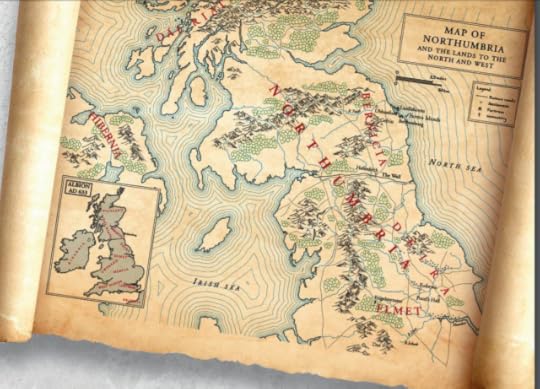
Tribal hatreds stoked the fires of kings’ ambitions and defeated enemies were led away in chains to become slaves. For thralls were commonplace in this time. Much as they had been in the empire of Rome, slaves were used to perform menial tasks and, as in Rome, they could become valued members of a household and could even be freed by their owners.It was a time long before revolutions of farming and industry and the people were truly at the mercy of nature. If the rains did not fall, or a frost came too early, or a storm destroyed crops, the people would go hungry, and perhaps even starve. It was not uncommon for people who were unable to scrape together enough food, to “place their heads in their lord’s hands”, meaning they were giving themselves as slaves, throwing themselves on his mercy and trusting that he would feed them.But it was not all doom and gloom. The people of the seventh century suffered great hardship and worked tirelessly to eke out a living from the land, but they also knew how to party! On feast days they would congregate in their lord’s great hall where they would sit around the central hearth fire, drinking copious amounts of ale and mead, listening to stories and songs of heroes, such as that oldest of English tales, Beowulf. The Anglo-Saxons loved games and would do their best to confound their friends and family with clever riddles such as:
A warrior is wondrously brought into the world
for the use of lords by two dumb things;
brightly extracted, which for his hurt
foe bears against foe. Strong though he is
a woman binds him. He obeys them well,
serves them quietly, if maids and men
tend him duly, feed him fairly.
He exalts them in comfort for their joy in life,
grimly rewards one who lets him grow proud.
Wiga is on eorþan wundrum acenned
dryhtum to nytte of dumbum twam
torht atyhted þone on teon wigeð
feond his feonde fer strangne oft
wif hine wrið he him wel hereð
þeowaþ him geþwære gif him þegniað
mægeð ⁊ mæcgas mid gemete ryhte ·
fedað hine fægre he him fremum stepeð
life on lissum leanað grimme
þe hine wloncne weorþan læteð This riddle is taken from Anglo-Saxon Riddles of the Exeter Book (1963), translated by Paull Franklin Baum.
The answer to the riddle is probably “Fire”, the two dumb things in the second line being flint and steel.
The food they ate at these feasts would be in some ways familiar to us, but in others quite different from what we are used to. This was long before Europeans travelled to the New World and therefore there would be no tomatoes or potatoes or other such food we take for granted in the 21st century. In spring, when lambs and calves were killed so that animals would continue to produce milk, meat would have been plentiful. At other times of the year, most of the food eaten, especially by the commoners, would have been seasonal vegetables, supplemented when possible by hunting and fishing. The other time when everybody would have meat would be in November, or Blotmonath as the Anglo-Saxons called it. For this was the month when many of the animals were slaughtered. Much of the meat would be salted or smoked to see them through the winter months but there would always be a feast after the harvest and before winter’s chill hand gripped the land.In many ways it can be considered a primitive society, warlike and brutal, and yet it is also a time of exquisite craftsmanship with metalwork producing the fine Sutton Hoo helmet and the swords and ornaments of the Staffordshire hoard.
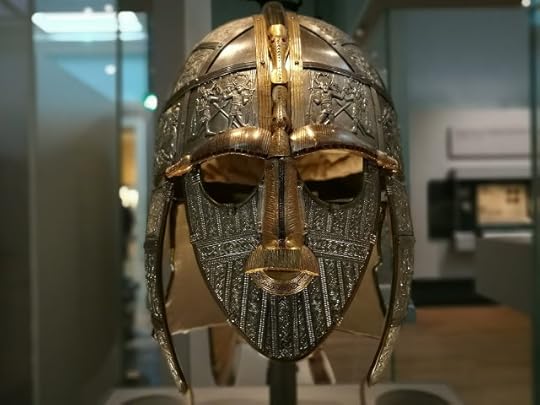 Sutton Hoo helmet
Sutton Hoo helmetChristianity was resurging across Britain, and with it came the written word and beautiful illuminated scripts such as the Lindisfarne Gospels, which were produced probably in the late seventh century.
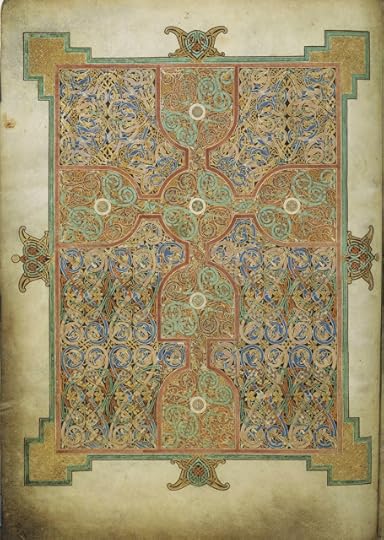 Lindisfarne Gospels
Lindisfarne GospelsAnd so, as with all periods of history, it was a time of juxtaposition, of darkness and light, violence and peaceful meditation, learning and ignorance. It was 1,400 years ago, centuries before industrialised farming and steam power. And over a millennium before electricity, television, the Internet, and social media. It was an age that was truly dark, when the only way to shed light in the gloom of the houses and halls was with the flickering flames of fat-dipped rush lights, candles or the embers on the hearth stone.
But have things truly changed that much? With all our technology and knowledge it seems to me the world is just as divided, with dichotomies just as stark as in the seventh century. The saddest thing is that now, in the enlightened, knowledge-rich 21st century, we have no excuse. We are in a time that should be fabulously light, blindingly bright even. Yet it seems that tragically, despite many striving for the light, much of humankind, as if terrified of what they might see should the shadows be lifted, will always seek out the darkness.
Matthew Harffy
 Matthew Harffy lived in Northumberland as a child and the area had a great impact on him. The rugged terrain, ruined castles and rocky coastline made it easy to imagine the past. Decades later, a documentary about Northumbria's Golden Age sowed the kernel of an idea for a series of historical fiction novels. The first of them is the action-packed tale of vengeance and coming of age, THE SERPENT SWORD.
Matthew Harffy lived in Northumberland as a child and the area had a great impact on him. The rugged terrain, ruined castles and rocky coastline made it easy to imagine the past. Decades later, a documentary about Northumbria's Golden Age sowed the kernel of an idea for a series of historical fiction novels. The first of them is the action-packed tale of vengeance and coming of age, THE SERPENT SWORD.Matthew has worked in the IT industry, where he spent all day writing and editing, just not the words that most interested him. Prior to that he worked in Spain as an English teacher and translator. Matthew lives in Wiltshire, England, with his wife and their two daughters.
Matthew loves to hear from readers, you can find him: Website Facebook Twitter
Warrior of Woden (Book five of the Bernicia Chronicles)
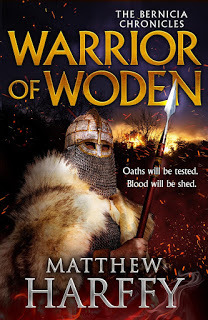 AD 642. Anglo-Saxon Britain. A gripping, action-packed historical thriller and the fifth instalment in the Bernicia Chronicles. Perfect for fans of Bernard Cornwell.
AD 642. Anglo-Saxon Britain. A gripping, action-packed historical thriller and the fifth instalment in the Bernicia Chronicles. Perfect for fans of Bernard Cornwell.Oswald has reigned over Northumbria for eight years and Beobrand has led the king to ever greater victories. Rewarded for his fealty and prowess in battle, Beobrand is now a wealthy warlord, with a sizable warband. Tales of Beobrand's fearsome black-shielded warriors and the great treasure he has amassed are told throughout the halls of the land.
Many are the kings who bow to Oswald. And yet there are those who look upon his realm with a covetous eye. And there is one ruler who will never kneel before him.
When Penda of Mercia, the great killer of kings, invades Northumbria, Beobrand is once more called upon to stand in an epic battle where the blood of many will be shed in defence of the kingdom.
But in this climactic clash between the pagan Penda and the Christian Oswald there is much more at stake than sovereignty. This is a battle for the very souls of the people of Albion.
Read the Bernicia Chronicles series today!
The Serpent Sword Cross and Curse Blood and Blade Killer of Kings Warrior of Woden
Published on February 14, 2018 23:00
February 13, 2018
When Inspiration Strikes . . . Treasure Love by Vanda Vadas #ValentinesDay #Love @Vanda_Vadas
Please give a warm welcome to historical fiction author, Vanda Vadas.
When Inspiration Strikes . . .
Mary Anne, it’s a pleasure to be invited back to your blog! Thank you.
I’m often asked from what or where do I draw inspiration to write. Inspiration is endless and often comes from the most unlikely sources. It could be an experience, a place, a person, an object or image.
Such is the case with my new release, TREASURED LOVE, a mix of historical and contemporary short stories.
Queen of Diamonds was conceived after having visited a musical production at a casino in my locale. When exiting the show and walking past the gambling area, my husband and I heard the customary rattle of money in slot machines, the sound of spinning roulette wheels, and sighted row upon row of card related games. An idea sparked, and I had my story . . .
Grace is a croupier at a casino, the consummate professional with unwavering concentration. She is caught off-guard when a stranger with piercing blue eyes takes a seat at her table. Blackjack is not the only hand he sets out to win.

One of my favourite destinations, the picturesque Blue Mountains in NSW, Australia, inspired A Passionate Love. I have a book which showcases photographs of beautiful gardens in this area, one of which struck a chord with me: a grand tree-lined driveway shrouded in mountain mist. The air of mystery in the photograph inspired George and Edith’s story . . .
Cherry Tree Lodge in the Blue Mountains of NSW, Australia, is no ordinary Bed and Breakfast. It harbours a secret, one that is connected to a Bohemian brooch, a photograph and a child’s wisdom. Truths are revealed in the indelible footprints of a passionate love.

Lovin’ You came about when observing late afternoon sunlight filtering through cedar blinds. I watched the shifting shadows as daylight waned and from somewhere deep in my memory song lyrics came to mind: ‘Inside a broken dream I cry. Is love the reason why? Inside an empty room I stare, at love that is not there.’ That moment morphed into this story . . .
Compromise is a two-way street. Not so for Connor and Kate. Consequent to personal sacrifice and broken promises, their marriage is on a downward spiral. Salvation is at hand if only fears are faced.

Winter Hill, in Buckinghamshire, England, affords excellent views over the Thames Valley and Chiltern Hills. The locale holds special memories for me and is the inspiration behind Unbroken Bonds . . .
Finding your soul mate is one thing, marrying her and never letting go is another. Cedric succeeded on all counts. No regrets. Even though he now fights a losing battle, nothing can sever the ties with his one true love.
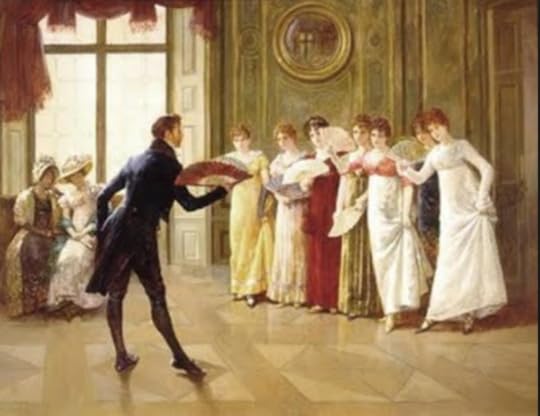
Inspiration behind the final story sprang from a particular glass bottle. That, and a gemstone which graces the story’s title, Liquid Sapphire . . .
Josh works nights as a barman in an exclusive hotel. When a woman his age enters the bar in search of employment, Josh has good reason to stare. She’s dressed like a cowgirl ready to rope a calf in a country rodeo. What could she possibly know about champagne, swizzle sticks and cocktails?

I trust you’ll delight in reading these five short stories. Love is not limited to age. It’s timeless and for the young and the mature at heart. Be it that sizzling first meet-cute romance or time-tested relationship, this collection of touching tales demonstrates themes of love, loss and marriage.
Each story in Treasured Love makes for the perfect coffee break read. What better way to celebrate love than today, Valentine’s Day!

You can find out more about this book at Vanda’s Website or buy the book Here
Vanda Vadas
 Before residing in Australia, Vanda’s birthplace and early childhood years were spent in Papua New Guinea. At the age of eleven, a holiday in England sparked an interest in the days of old. Castles, ruins and discovering Jane Austen novels inspired a life-long interest in all things historical, a passion that later kick-started Vanda’s desire to write historical fiction.
Before residing in Australia, Vanda’s birthplace and early childhood years were spent in Papua New Guinea. At the age of eleven, a holiday in England sparked an interest in the days of old. Castles, ruins and discovering Jane Austen novels inspired a life-long interest in all things historical, a passion that later kick-started Vanda’s desire to write historical fiction.Her locale and global visits to faraway places inspire Vanda’s creation of fictitious characters and dramas – past and present – set against authentic and geographical backdrops. Her debut novel, The Pirate Lord (Random House Australia) was an Amazon #1 Best Seller in Historical Romance. Her next novel, a Scottish Historical set post the Battle of Culloden, will be published later this year.
The Gold Coast is home to Vanda and her husband where they enjoy walks along world-renowned beaches or a quiet getaway to the lush hills of the Hinterland.
Vanda loves to hear from her readers. You can find her at:
Website Facebook Twitter
Published on February 13, 2018 23:00
February 12, 2018
Author’s Inspiration ~ Gunpowder, Treason and plot ~ Tony Morgan #HistoricalFiction @MorgantheBook
Please give a warm welcome to historical Fiction author, Tony Morgan.
Author’s InspirationGunpowder, Treason and plot
This blog describes what inspired me to write two novels focused on the events and aftermath of the Gunpowder Plot of the early Seventeenth Century.

In truth, it all started with a creative writing exercise. I was tasked with coming up with a six-word sentence which could be the first line or even the title of a book. Pique the reader’s interest. Make them want to ask questions. Lure them in to wanting to find out more. (That’s what I was instructed to do anyway! Whether I got it right or not, only readers and potential readers can judge…)
The time of year was late autumn, a few days after Halloween, around the time in the UK when our evening skies are filled with fireworks, smoke from bonfires and burning effigies of a man called Guy.

It was around 7:30pm. I stared through the window into the darkness. I let my mind wander and wondered. The words “Remember, Remember the 6th of November” came into my head.
Perhaps people will want to know why I’ve selected the 6th and not the 5th, I thought. Some people might even be riled enough to tell me I’ve made a mistake. If they did so, at least they’d be engaged was my view. As it turns out quite a few people (mainly from outside the UK) have told me I’ve got my dates wrong…
So, I had, what I thought, was an intriguing title but no story. What about writing an account of the Gunpowder Plot, I asked myself? And I was sitting in York where the apparent protagonist (and the man on the fire) was born but the more I thought about the subject the more I realised how little I knew.
I started researching and reading. Hard copies, paperbacks, histories. My Kindle creaked with the facts. My favourite work was “The Gunpowder Plot: Terror and Faith in 1605” by Lady Antonia Fraser. I began to learn and understand. The parallels with modern life jumped out at me – religious unrest, terrorists on the streets of London, conflict with Europe, conspiracies, the topic of increasing government surveillance.
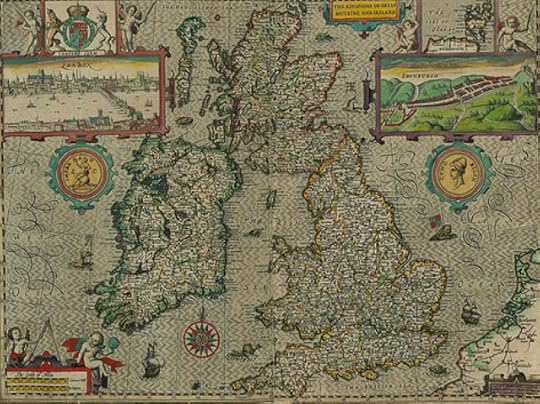
What’s more, other than the name of Guy Fawkes and an attempt to use gunpowder to blow up Parliament, myself and so many other people knew so little about it. I had to find out more.
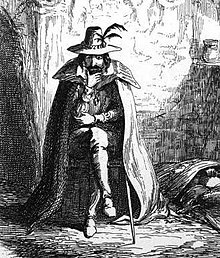 George Cruikshank's illustration of Guy Fawkes,
George Cruikshank's illustration of Guy Fawkes,
This was history at its most compelling. A critical point in a nation’s, perhaps even the world’s, timeline. Why were people on both sides (Protestant and Catholic, plotter and establishment) doing what they did? Why did events turn out the way they did? What if things had been different?
In short, I was hooked…
I wrote a short story. It was fact heavy and frankly a little bit rubbish. I started again and wrote a better novel-length story, with two intertwined timelines. One was set in the first week of 1605. This told the history through the eyes and actions of Guy Fawkes, Robert Catesby, the plotters and their families, King James, Anne of Denmark, Robert Cecil, his rumoured lover Katherine of Suffolk and others. The second timeline was set in a subtly altered modern day. I trialled a draft on a number of people, including a book club. A few loved the modern element but the majority, including the book club members, raved about the historical section.
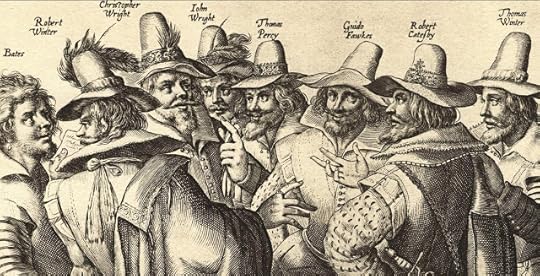
I re-wrote the story to create the final version. I dropped the modern-day thread and extended the historical sections. The plot developed into a thriller set over the first week of November 1605, leading not just into the 5thbut the 6th also. I did get my dates right after all. The reviews on Amazon etc to date have been excellent. I hope you like it. Please let me know either way.
The initial Kindle ebook came out a year before the BBC’s Gunpowder mini- series, which debuted in 2017. I watched with interest but also a little disappointment. In an attempt to create an exciting story, my view is the producers diverged too much from the actual facts and ended up not getting either quite right. And you can't get much more exciting than what really happened anyway!
On the positive side, the timing of the TV show was excellent. It coincided with the release of a paperback version of “Remember, Remember the 6th of November”, the ebook release of the sequel “1617” and helped me sell more books and raise even more money for my chosen good causes.
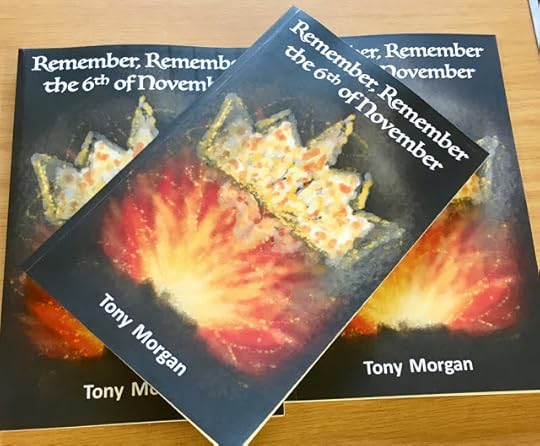
The inspiration for the second book “1617” is quite simply “what if?”, specifically “what if the Gunpowder Plot had at least partially succeeded?”. If the King had been killed, history would have taken an alternate route. What a great opportunity for an author to close their eyes for a moment and imagine…
Tony Morgan
 Tony Morgan lives in Yorkshire in the UK, close to the birthplace of Guy Fawkes. His books have been described as a perfect read for lovers of the works of C.J. Sansom and S. J. Parris and anyone interested in how historic events have shaped our own times. Profits from his books to date have raised hundreds of pounds for good causes, including Save the Children UK and York Teaching Hospital Charity’s dementia appeal.
Tony Morgan lives in Yorkshire in the UK, close to the birthplace of Guy Fawkes. His books have been described as a perfect read for lovers of the works of C.J. Sansom and S. J. Parris and anyone interested in how historic events have shaped our own times. Profits from his books to date have raised hundreds of pounds for good causes, including Save the Children UK and York Teaching Hospital Charity’s dementia appeal.
Tony Loves to hear from readers, you can find him: Website Twitter
Remember, Remember the 6th of November
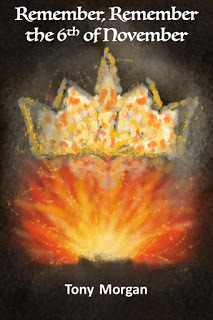 Remember, Remember the 6th of November is a thrilling retelling of the story of Guy Fawkes and the Gunpowder Plot.England in 1605 is a country concerned about terrorism, religious tensions, government surveillance and conflicts with Europe. A small group of conspirators led by charismatic Robert Catesby and Guy Fawkes plan regime change. In a race against time can spymaster Robert Cecil and his lover Katherine Suffolk prevent the country descending into all-out civil war
Remember, Remember the 6th of November is a thrilling retelling of the story of Guy Fawkes and the Gunpowder Plot.England in 1605 is a country concerned about terrorism, religious tensions, government surveillance and conflicts with Europe. A small group of conspirators led by charismatic Robert Catesby and Guy Fawkes plan regime change. In a race against time can spymaster Robert Cecil and his lover Katherine Suffolk prevent the country descending into all-out civil war
Amazon US Amazon UK
1671
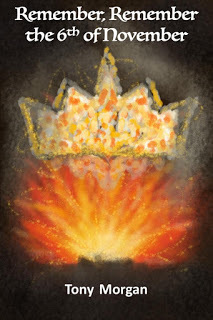 1617 is the exciting sequel to Remember, Remember the 6th of November - a thrilling alternate history filled with secrets, treachery and intrigue. Queen Elizabeth has transformed England into a centre for religious tolerance but conflict is brewing across Europe and there are continued troubles in Ireland. A peace envoy is needed. Sir Everard Digby appears the perfect choice but he’s a man with a secret past which the Queen must never discover…
1617 is the exciting sequel to Remember, Remember the 6th of November - a thrilling alternate history filled with secrets, treachery and intrigue. Queen Elizabeth has transformed England into a centre for religious tolerance but conflict is brewing across Europe and there are continued troubles in Ireland. A peace envoy is needed. Sir Everard Digby appears the perfect choice but he’s a man with a secret past which the Queen must never discover…
Amazon US Amazon UK
Author’s InspirationGunpowder, Treason and plot
This blog describes what inspired me to write two novels focused on the events and aftermath of the Gunpowder Plot of the early Seventeenth Century.

In truth, it all started with a creative writing exercise. I was tasked with coming up with a six-word sentence which could be the first line or even the title of a book. Pique the reader’s interest. Make them want to ask questions. Lure them in to wanting to find out more. (That’s what I was instructed to do anyway! Whether I got it right or not, only readers and potential readers can judge…)
The time of year was late autumn, a few days after Halloween, around the time in the UK when our evening skies are filled with fireworks, smoke from bonfires and burning effigies of a man called Guy.

It was around 7:30pm. I stared through the window into the darkness. I let my mind wander and wondered. The words “Remember, Remember the 6th of November” came into my head.
Perhaps people will want to know why I’ve selected the 6th and not the 5th, I thought. Some people might even be riled enough to tell me I’ve made a mistake. If they did so, at least they’d be engaged was my view. As it turns out quite a few people (mainly from outside the UK) have told me I’ve got my dates wrong…
So, I had, what I thought, was an intriguing title but no story. What about writing an account of the Gunpowder Plot, I asked myself? And I was sitting in York where the apparent protagonist (and the man on the fire) was born but the more I thought about the subject the more I realised how little I knew.
I started researching and reading. Hard copies, paperbacks, histories. My Kindle creaked with the facts. My favourite work was “The Gunpowder Plot: Terror and Faith in 1605” by Lady Antonia Fraser. I began to learn and understand. The parallels with modern life jumped out at me – religious unrest, terrorists on the streets of London, conflict with Europe, conspiracies, the topic of increasing government surveillance.

What’s more, other than the name of Guy Fawkes and an attempt to use gunpowder to blow up Parliament, myself and so many other people knew so little about it. I had to find out more.
 George Cruikshank's illustration of Guy Fawkes,
George Cruikshank's illustration of Guy Fawkes,This was history at its most compelling. A critical point in a nation’s, perhaps even the world’s, timeline. Why were people on both sides (Protestant and Catholic, plotter and establishment) doing what they did? Why did events turn out the way they did? What if things had been different?
In short, I was hooked…
I wrote a short story. It was fact heavy and frankly a little bit rubbish. I started again and wrote a better novel-length story, with two intertwined timelines. One was set in the first week of 1605. This told the history through the eyes and actions of Guy Fawkes, Robert Catesby, the plotters and their families, King James, Anne of Denmark, Robert Cecil, his rumoured lover Katherine of Suffolk and others. The second timeline was set in a subtly altered modern day. I trialled a draft on a number of people, including a book club. A few loved the modern element but the majority, including the book club members, raved about the historical section.

I re-wrote the story to create the final version. I dropped the modern-day thread and extended the historical sections. The plot developed into a thriller set over the first week of November 1605, leading not just into the 5thbut the 6th also. I did get my dates right after all. The reviews on Amazon etc to date have been excellent. I hope you like it. Please let me know either way.
The initial Kindle ebook came out a year before the BBC’s Gunpowder mini- series, which debuted in 2017. I watched with interest but also a little disappointment. In an attempt to create an exciting story, my view is the producers diverged too much from the actual facts and ended up not getting either quite right. And you can't get much more exciting than what really happened anyway!
On the positive side, the timing of the TV show was excellent. It coincided with the release of a paperback version of “Remember, Remember the 6th of November”, the ebook release of the sequel “1617” and helped me sell more books and raise even more money for my chosen good causes.

The inspiration for the second book “1617” is quite simply “what if?”, specifically “what if the Gunpowder Plot had at least partially succeeded?”. If the King had been killed, history would have taken an alternate route. What a great opportunity for an author to close their eyes for a moment and imagine…
Tony Morgan
 Tony Morgan lives in Yorkshire in the UK, close to the birthplace of Guy Fawkes. His books have been described as a perfect read for lovers of the works of C.J. Sansom and S. J. Parris and anyone interested in how historic events have shaped our own times. Profits from his books to date have raised hundreds of pounds for good causes, including Save the Children UK and York Teaching Hospital Charity’s dementia appeal.
Tony Morgan lives in Yorkshire in the UK, close to the birthplace of Guy Fawkes. His books have been described as a perfect read for lovers of the works of C.J. Sansom and S. J. Parris and anyone interested in how historic events have shaped our own times. Profits from his books to date have raised hundreds of pounds for good causes, including Save the Children UK and York Teaching Hospital Charity’s dementia appeal.Tony Loves to hear from readers, you can find him: Website Twitter
Remember, Remember the 6th of November
 Remember, Remember the 6th of November is a thrilling retelling of the story of Guy Fawkes and the Gunpowder Plot.England in 1605 is a country concerned about terrorism, religious tensions, government surveillance and conflicts with Europe. A small group of conspirators led by charismatic Robert Catesby and Guy Fawkes plan regime change. In a race against time can spymaster Robert Cecil and his lover Katherine Suffolk prevent the country descending into all-out civil war
Remember, Remember the 6th of November is a thrilling retelling of the story of Guy Fawkes and the Gunpowder Plot.England in 1605 is a country concerned about terrorism, religious tensions, government surveillance and conflicts with Europe. A small group of conspirators led by charismatic Robert Catesby and Guy Fawkes plan regime change. In a race against time can spymaster Robert Cecil and his lover Katherine Suffolk prevent the country descending into all-out civil warAmazon US Amazon UK
1671
 1617 is the exciting sequel to Remember, Remember the 6th of November - a thrilling alternate history filled with secrets, treachery and intrigue. Queen Elizabeth has transformed England into a centre for religious tolerance but conflict is brewing across Europe and there are continued troubles in Ireland. A peace envoy is needed. Sir Everard Digby appears the perfect choice but he’s a man with a secret past which the Queen must never discover…
1617 is the exciting sequel to Remember, Remember the 6th of November - a thrilling alternate history filled with secrets, treachery and intrigue. Queen Elizabeth has transformed England into a centre for religious tolerance but conflict is brewing across Europe and there are continued troubles in Ireland. A peace envoy is needed. Sir Everard Digby appears the perfect choice but he’s a man with a secret past which the Queen must never discover…Amazon US Amazon UK
Published on February 12, 2018 23:00
February 11, 2018
Author’s Inspiration ~ Trisha Hughes #HistoricalFiction #amreading @TrishaHughes
Please give a warm welcome to historical fiction author, Trisha Hughes.
Author’s Inspiration
 While I am not an historian, what I do have is a passion for British history that began many years ago while I was pregnant with my first child. I spent endless days in the library consuming everything I could and writing it all in a notebook. Over the years, through moving house, raising children and everyday life, the notebook disappeared but my interest in British Monarchy hasn't. Five years ago, the interest turned into passion and here I am with the first two books of my trilogy on British Monarchy sitting on the shelves.I remember the day it all began. I was talking to my grandson about his interests. I even did what every grandparent does ... I asked what he wanted to be when he grew up and I asked what subjects he was taking at school. And it turned out that history was one of them. Brightened that we had something to talk about to take his mind off his Facebook page, I said to him 'So you know all about Henry VIII.'It was a statement, not a question, and I fully expected him to say 'of course'. Everyone knows who Henry VIII is. Right? Instead, I was greeted with a blank look. I asked, 'You DO know who Henry VIII was, right?' Apparently not.Well, he knows now. We sat and I talked for more than an hour on the subject and I told him the whole sordid story of Henry and his wives, the beheadings, the urgent need for a male heir and the transformation from charismatic eighteen-year-old to obese tyrant. I told him the story in a way he would understand and I tried to bring Henry back to life, not just as an eccentric character from a history book, but as a real life person. And he was entralled. He laughed when he was supposed to laugh and he was shocked when he was supposed to be shocked. His reaction made me stop and think. Why don’t children know more about the past?
While I am not an historian, what I do have is a passion for British history that began many years ago while I was pregnant with my first child. I spent endless days in the library consuming everything I could and writing it all in a notebook. Over the years, through moving house, raising children and everyday life, the notebook disappeared but my interest in British Monarchy hasn't. Five years ago, the interest turned into passion and here I am with the first two books of my trilogy on British Monarchy sitting on the shelves.I remember the day it all began. I was talking to my grandson about his interests. I even did what every grandparent does ... I asked what he wanted to be when he grew up and I asked what subjects he was taking at school. And it turned out that history was one of them. Brightened that we had something to talk about to take his mind off his Facebook page, I said to him 'So you know all about Henry VIII.'It was a statement, not a question, and I fully expected him to say 'of course'. Everyone knows who Henry VIII is. Right? Instead, I was greeted with a blank look. I asked, 'You DO know who Henry VIII was, right?' Apparently not.Well, he knows now. We sat and I talked for more than an hour on the subject and I told him the whole sordid story of Henry and his wives, the beheadings, the urgent need for a male heir and the transformation from charismatic eighteen-year-old to obese tyrant. I told him the story in a way he would understand and I tried to bring Henry back to life, not just as an eccentric character from a history book, but as a real life person. And he was entralled. He laughed when he was supposed to laugh and he was shocked when he was supposed to be shocked. His reaction made me stop and think. Why don’t children know more about the past?Have you ever wondered why it is that when we hear an almost forgotten song, we can remember every single word? Thirty years on, the song is as fresh in our minds as when we first heard it and whether we can hold a tune or not, we sing along with it and we remember the words exactly. So the six million dollar question is, if we can remember songs so well, why don’t we do the same with history?
When I was at school, learning about the Magna Carta, the Battle of Hastings, Agincourt, Bosworth, Bannockburn, along with the names of unknown Kings fighting unknown battles in unknown places was the most boring lessons I could imagine. In the back of my mind was the question, ‘Why do I have to learn about history when I’ll never use it again when I grow up?’
Being considerate of teachers and the curriculum they’re given, we know they have guidelines. And we know they have time constraints. But now that we’re older and wiser, we understand that our children can learn a lot by looking closer at the past. Our perception changes, as does our interests. All of a sudden, these characters aren’t eccentric anymore and we realise they were real people with real personalities. They fought battles, they won the love of their women, they made mistakes and they were vulneralbe to diseases. Just like us. All of a sudden it becomes exciting. It’s like being a time-detective, hunting through the records and the archaeological artifacts, looking for clues that might help build up a picture of what happened long ago.
Then, almost like a revelation, we realise that learning history has many important benefits as well. By understanding our past, and where we came from, we hope to better understand where we are now and even decide about what might happen in the future. The way things are now is a consequence of the things that happened in the past. The way things will be tomorrow will be a consequence of the way things are now. Considering the greed that caused The War of the Roses, the family misunderstandings that caused the First World War and the need for power that caused the Second World War, who would want to repeat those mistakes? So, keeping that in mind, shouldn’t we be teaching the importance of this to our children? If we don’t teach our children to connect with history, then the consequences for our society could be disastrous. The more we know about the past the better prepared we are for the future.
All of this was running madly around in my brain. And that’s when I decided to write about the history of British Monarchs. I wanted the story to be factual and interesting without being academic. I wanted it to grab the reader’s imagination and I wanted it be fun.
'VIKINGS TO VIRGIN' - The Hazards of being King' is the first in my trilogy released in 2017. Following that book is the second in the series, ' VIRGIN TO VICTORIA -The Queen is dead. Long live the Queen' due for release on 28th April this year. The last one 'VICTORIA TO VIKINGS - The Circle of Blood' is in the final stages and will be released early next year.
If you know anything at all about British monarchs, you'll know that among the good and well-meaning monarchs, some of them were ruthless, not to mention greedy, murderous, adulterers, swindlers, cowards and totally corrupt. Their story is better than a thriller about a serial killer on the loose because this story is absolutely true. Don't imagine a fairy story with handsome kings in wondrous castles whisking off princesses on their white horses to the sound of trumpets and the cheers of their people. Imagine powerful individuals who were brutal and would stop at nothing to get what they wanted and who were more than happy to get rid of the odd family member or two who were standing in the way of their progress to the throne.
My goal is to bring all the kings and queens back to life again with all of the heroism, betrayals and lust that was just part of the times they lived in. Some reigned for years, some reigned for weeks. Some should never have reigned at all. But they all had one thing in common. In those days, these kings and queens were the most powerful men and women in the country and their power was absolute.
In the immortal words of Rudyard Kipling,
‘If history were taught in the form of stories, it would never be forgotten.’
And that’s what I’ve tried to do. I hope you enjoy reading my books as much as I’ve enjoyed writing them.
Trisha Hughes
 I was born in a little outback town called Blackall in Central Queensland, Australia. From there my parents moved to the Brisbane suburb of Fortitude Valley where I grew up to be a tiny, self-reliant little girl.
I was born in a little outback town called Blackall in Central Queensland, Australia. From there my parents moved to the Brisbane suburb of Fortitude Valley where I grew up to be a tiny, self-reliant little girl.My first book, ‘Daughters of Nazareth’ is my story, written eighteen years ago, fuelled on by the discovery of a family I never knew I had. It’s full of family secrets, tremendous heartache but proves the human spirit’s amazing ability to triumph over adversity. Nineteen years ago, after just one phone call, my life changed abruptly. With that change came a passion for writing and I have been writing ever since.
I love writing crime novels but my passion is with the history of the British Monarchy. The first in my ‘V2V’ trilogy is ‘Vikings to Virgin – The Hazards of being King ’ published in 2017. The second in the series is due for release on 28th April this year and is called ‘Virgin to Victoria – The Queen is Dead. Long live the Queen.’ The final book, ‘Victoria to Vikings – The Circle of Blood’ will be released early 2019.
Trisha loves to hear from readers. You can find her... Website Twitter Facebook
Vikings to VirginThe Hazards of being King
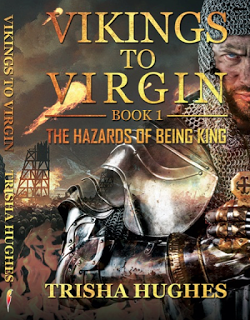 In Vikings to Virgin - The Hazards of Being King Trisha Hughes provides the reader with a pacey introduction to the many pitfalls faced by the ambitious as they climbed the dangerous ladders of royalty. It is easy to think that monarchs are all powerful, but throughout the Dark and Middle Ages it was surprisingly easy to unseat one and assume the crown yourself. But if it was easy to gain ... it was just as easy to lose.
In Vikings to Virgin - The Hazards of Being King Trisha Hughes provides the reader with a pacey introduction to the many pitfalls faced by the ambitious as they climbed the dangerous ladders of royalty. It is easy to think that monarchs are all powerful, but throughout the Dark and Middle Ages it was surprisingly easy to unseat one and assume the crown yourself. But if it was easy to gain ... it was just as easy to lose.From the dawn of the Vikings through to Elizabeth I, Trisha Hughes follows the violent struggles for power and the many brutal methods employed to wrest it and keep hold of it. Murder, deceit, treachery, lust and betrayal were just a few of the methods used to try and win the crown. Vikings to Virgin - The Hazards of Being King spans fifteen hundred years and is a highly accessible and enjoyable ride through the dark side of early British monarchy.
Amazon US Amazon UK
Virgin to Victoria
The Queen is Dead. Long live the Queen
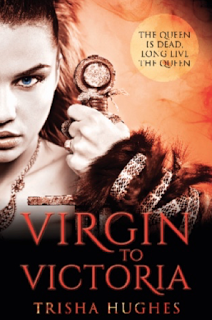 After the death of Elizabeth I’s sister, ‘Bloody Mary’, England had high hopes for their new queen when she came to the throne. 25-year-old Elizabeth I attended her first council exuding an air of quiet confidence, even though she was inheriting a bankrupt nation torn apart by religious discord. It was chaotic.
After the death of Elizabeth I’s sister, ‘Bloody Mary’, England had high hopes for their new queen when she came to the throne. 25-year-old Elizabeth I attended her first council exuding an air of quiet confidence, even though she was inheriting a bankrupt nation torn apart by religious discord. It was chaotic.Despite her amazing legacy and despite what her father, Henry VIII, had desired above all else, Elizabeth failed England in one vital point. She never married and did not leave an heir to the Tudor dynasty. By making that one fateful decision, she left the path open for the Stuarts in Scotland to take over and life would never be the same.
‘Virgin to Victoria’ travels in time through Elizabeth I’s amazing life, through the confusion of the Stuart dynasty, through the devastation of a Civil War led by Oliver Cromwell, through horrific battles for the throne and through the turbulent and discordant Hanover dynasty with its intricate family squabbles.
Queen Victoria did not ask to be Queen. It was thrust upon her by the accident of birth and then by a succession of accidents that removed all others who stood between her and the throne. She assumed it reluctantly and, at first, incompetently. Parliament was sure the 18-year-old could be relied upon to leave the job of running the country to the professionals.
Couldn’t she?
Coming soon!
Books can be purchased through Amazon, Book Depository, and most on-line outlets and personally signed copies through my website: www.vikingstovirgin.com
Published on February 11, 2018 23:00
#BookReview ~ Red Winter by Julia Underwood #HistoricalFiction #Russia #mustread @BeingJules
Red Winter
By Julie Underwood
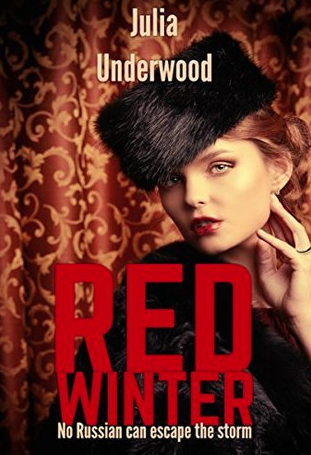
Wealthy, privileged Sophie Cooke, the eldest daughter of a successful English businessman in St Petersburg, has her life torn apart by historic changes in Russia.
In the early 1900s, enjoying a luxurious existence and a social life of parties and balls, Sophie becomes engaged to the love of her life; a young doctor, Anatoly Andropov. The outbreak of the Great War means that their marriage is earlier than planned and Tolya goes to serve in a field hospital on the eastern front.
Sophie, bored and lonely at home, leaves to join him as a nurse. Later she gives birth to a baby boy and, when expecting her second child, conditions compel her to return to her home city, now named Petrograd.
Petrograd becomes the epicentre of the greatest upheaval in Russian history where the Tsar is overthrown and socialist revolutionaries take over the government. During the months and years that follow, the socialist revolution and a bitter Civil War play out amidst uncertainty, lethal danger and brutal violence. Sophie’s family flee to England, to safety, but even that escape is marked with tragedy.
Sophie remains in Petrograd with her children to wait Tolya’s return. Conditions in the city deteriorate, threatening her little family with starvation and disease. Sophie endures endless struggles at home and at work in a state hospital with the fate of her husband always on her mind. Where is he? Is he even alive? Serious illness and the fragile health of her children drive her to join her family in England where she hears the worst news possible which forces her to return alone to Russia to embark on a dangerous quest.
This sweeping novel of love and loss will transport the reader from tsarist Russia in 1913, through the Great War, the Russian Revolution and Civil War to 1922, finally portraying the life of Russian émigrés in England.
The Coffee Pot Book Club Review
 When Sophie married the dashing young doctor, Anatoly Andropov, she had no idea where her life would lead her. In the years that follow, Sophie would witness the horrors of World War I and the terror of the 1917 revolution. Being half-English, Sophie has the chance to leave Russia with her family, but how can she when she knows not what has happened to her husband?
When Sophie married the dashing young doctor, Anatoly Andropov, she had no idea where her life would lead her. In the years that follow, Sophie would witness the horrors of World War I and the terror of the 1917 revolution. Being half-English, Sophie has the chance to leave Russia with her family, but how can she when she knows not what has happened to her husband?From the splendour of Tsarist Russia to the abject poverty of life under the Bolsheviks, Red Winter by Julia Underwood is a sweeping saga of one young woman as she fights for her country, her family, and the man she loves. The brutality of this time is beautifully portrayed in one of the best historical fiction books I have ever read depicting this era. This book is right up there with Boris Pasternak, Doctor Zhivago, and Danielle Steel's, Zoya. Red Winter is a breathtaking story that had me gripped from the opening chapter — so gripped in fact that I simply could not put the book down and read it in one sitting.
Sophie was a beautifully portrayed protagonist, and while the world is falling down around her, she faces this changing world with courage and integrity. She is the glue that holds her family together, and her bravery is inspiring, as is her self-sacrifice. Sophie meets each disaster head on, and although at times she is discouraged she somehow finds the strength to carry on.
The depth of research, Julie Underwood has dedicated to portraying the period as accurately as she can has to be commended. I found no historical inaccuracies, and the story came across as very real in the telling.
An enjoyable story, filled with tragedy and hardship but with a satisfying ending.
I Highly Recommend.
Links for PurchaseAmazon US Amazon UK
Julia Underwood
 I have been writing for many years. At boarding school I took liberties with published work, adapting it into plays for my classmates to perform. Frequently in trouble for ignoring the 'no talking after lights' rule, I related an ongoing saga of terror and mayhem to my friends.
I have been writing for many years. At boarding school I took liberties with published work, adapting it into plays for my classmates to perform. Frequently in trouble for ignoring the 'no talking after lights' rule, I related an ongoing saga of terror and mayhem to my friends.My father was an Intelligence Officer in the British Army and, after World War 2 we lived in Germany and Austria. I have also lived and worked in Jamaica and France.
Before starting a family I worked as a Medical Research Scientist (I have a BSc in Physiology) for the NHS and the Athritis and Rheumatism Council. Running a pub and a restaurant were more stressful and difficult. Later, for many years I was an interior designer, also making soft furnishings.
I write fiction: short stories, children's stories, plays and now, a novel (published for Kindle by Endeavour Press). I have had short stories and articles published in magazines and have won and been short-listed in competitions with my short stories.
My obsessions are wrting, films, cats, cooking and doll's house furnishings (when I'm not writing I obsessively embroider 1"/12" scale replica carpets and knit dolls' house clothes on needles as thin as a wire).
I am now writng a series of murder mystery novellas for Kindle. The first 'A Murder of no Account' reached no:38 in the Amazon Free Kindle books chart and was 1,300th on the paid list for a nanosecond! I am now working on the second Eve Duncam mystery.
Published on February 11, 2018 08:12
February 9, 2018
Life in the time of… Mary, a Tudor Princess. By Tony Riches #History #Tudors #Giveaway @tonyriches
Life in the time of… Mary, a Tudor Princess.By Tony Riches
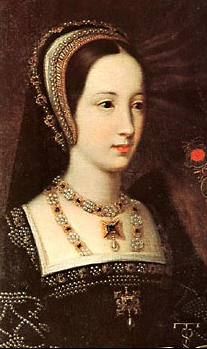
At the end of my Tudor Trilogy, Mary Tudor, daughter of King Henry VII, is beginning to realise her life will be quite different when her elder brother becomes King Henry VIII. Mary had always been her father’s favourite and even had her own household from the age of six.
She must have been precocious as a child, as her father liked to have her sing and dance and play the lute and clavichord to amuse foreign ambassadors. Of course, the most important thing he could do for his daughter was find her the perfect husband. After much deliberation he chose the future Holy Roman Emperor Charles V. Younger than Mary, Prince Charles would be an important ally and had more titles than he could remember.
Unfortunately for Mary, although she’d been looking forward to becoming Empress of Rome since childhood, her brother had a much better idea - and married her off to the decrepit and diseased fifty-two-year-old King Louis XII of France. Mary was barely eighteen at the time. She might have been a bit miffed but she knew her duty as a Tudor and made the best of it. Mary insisted on being referred to as the Queen of France for the rest of her life. (At least it helped avoid confusion with her niece, Henry VIII’s daughter Mary Tudor, later to become known as ‘Bloody Mary’.)
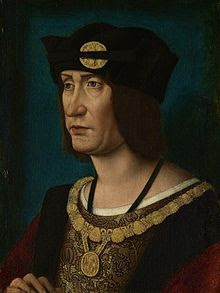 Louis XII Of France
Louis XII Of FranceMeanwhile, back in 1514, Henry VIII knew what he was doing, as Mary’s marriage formed the basis of a useful alliance with France. (He later offered his own daughter to Emperor Charles, although nothing ever came of it.) Unluckily, Mary’s marriage lasted barely ninety days, as her new husband died from his many illnesses. Rumours reached England from France that Mary had causing the death of King Louis with her ‘passionate exertions’.
It’s not impossible that the stories were gleefully spread by the mischievous courtiers of King Louis’ successor, King Francis. The problem for Mary was if she stayed in France she knew King Francis could marry her off to whoever he chose for political advantage. If she returned to England her brother would do the same. What actually became of her took both kings by surprise, as she risked her life to defy her brother – and is the subject of my new book, Mary – Tudor Princess
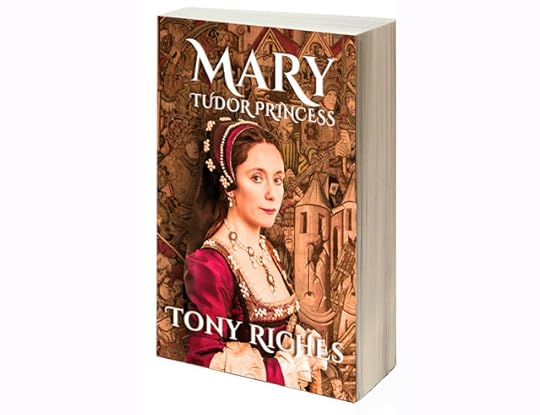
From the author of the international best-selling Tudor Trilogy, the true story of the Tudor dynasty continues with the daughter of King Henry VII, sister to King Henry VIII. Mary Tudor watches her elder brother become King of England and wonders what the future holds for her.
Born into great privilege, Mary has beauty and intelligence beyond her years and is the most marriageable princess in Europe. Henry plans to use her marriage to build a powerful alliance against his enemies. Will she dare risk his anger by marrying for love?
Meticulously researched and based on actual events, this 'sequel' follows Mary's story from book three of the Tudor Trilogy and is set during the reign of King Henry VIII.
Giveaway
Tony Riches is giving away one Kindle Copy of Mary, Tudor Princess
Giveaway Rules
• Giveaway ends at 11:59pm GMT on February 28th. You must be 18 or older to enter.• To enter, leave your name on the comment section below.• Winner will be announce on 1st March• All giveaway entrants agree to be honest and not cheat the systems; any suspect of fraud is decided upon by blog owner and the sponsor, and entrants may be disqualified at our discretion.• Winner has 48 hours to claim prize or new winner is chosen.
Links for PurchaseAmazon US Amazon UK
Tony Riches
 Tony Riches is a full-time author of best-selling historical fiction. He lives in Pembrokeshire, West Wales and is a specialist in the fifteenth century, with a particular interest in the Wars of the Roses and the lives of the early Tudors. For more information about Tony’s other books please visit his website tonyriches.com and his popular blog, The Writing Desk and find him on Facebook and Twitter @tonyriches.
Tony Riches is a full-time author of best-selling historical fiction. He lives in Pembrokeshire, West Wales and is a specialist in the fifteenth century, with a particular interest in the Wars of the Roses and the lives of the early Tudors. For more information about Tony’s other books please visit his website tonyriches.com and his popular blog, The Writing Desk and find him on Facebook and Twitter @tonyriches.
Published on February 09, 2018 23:00
February 8, 2018
#BlogTour ~ That Woman by Wayne Clark #Colonial #historicalfiction #HFVBTBlogTours @hfvbt @wayne_clark_1
Historical Virtual Book Tour Presents....
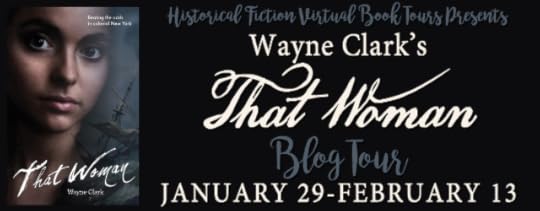
That WomanBy Wayne Clark
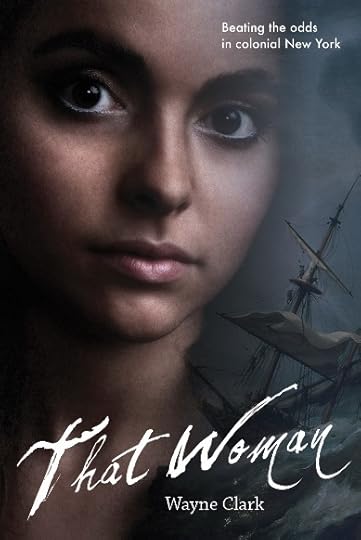
2017 Book Excellence Awards Finalist for Fiction2017 Winner 50 Great Writers You Should Be Reading
Kidnapped in France and brought to America as an indentured servant, a young woman takes on the brutal merchant king of New York’s East River waterfront…
Illness suddenly deprives 17-year-old Sarah Da Silva and her older brother Jacob of a mother. Before Sarah has come to terms with that loss, her merchant father grows frail and increasingly desperate in the face of impending bankruptcy. On the rainy night their father scours the docks of Bordeaux, France, to make his final bid to save his family, his children are kidnapped and forced onto a ship bound for New York City where they’ll be separated and sold to the highest bidder as indentured labor.Purchased by a grotesque merchant whose wealth, backed by a team of henchmen, allows him to dominate the chaotic East River docks, Sarah strikes back the only way she can. Vowing to never allow him to put his hands on her again, she presses a knife to his fat neck. She demands her freedom, a roof over her head and the means to start a business. Her leverage? Knowledge obtained on the voyage that would bring the big man to his knees forever. He yields to her demands but privately swears to become her worst nightmare.
Praise for That Woman
“…Well-stocked with vibrant details about the merchant trade, this engaging Colonial tale delivers likable heroes, despicable villains, and a strong female protagonist.” Kirkus Reviews
“…Here is a story that dramatically captures the spirit of colonialism and slavery, with a masterful handling of the theme of freedom. Readers are taken on a roller coaster ride to colonial New York to witness a drama that will take their breath away. It’s utterly mesmerizing and tantalizing. 5 stars.”Romuald Dzemo for Readers’ Favorite
Excerpt
October 29, 1748 Bordeaux, France
IT WAS the highlight of Sarah’s week when her father signaled for her and her older brother Jacob to prepare themselves to accompany him while he conducted business on the quays of Bordeaux. Preparation meant simply to spruce up, straighten up and, above all, look up. Show that you are someone, he would say.
Since his wife died two years earlier, Gabriel Da Silva had placed his children on the pedestal his wife used to occupy. His taciturnity at home still made the days long, but Sarah had her brother to chatter with as they worked in the shop, its little office upstairs and the warehouse on the third floor. When Jacob teased her, which he would find any excuse to do, she laughed. Since their mother had died their father no longer barked out their names when he caught them playing word games while supposedly doing his accounts, or playing hide and seek in the store room when they were supposed to be finding space for a new consignment of goods. Mostly it was wine from their father’s best client, a producer in Pessac, a short distance southwest of the city.
Gabriel Da Silva was not a major merchant, so he was particularly proud of acting on behalf of the prestigious winery that had been in production for hundreds of years on the order of Pope Clément, a former archbishop of Bordeaux. Da Silva never had a problem with Catholics. Jews no longer had to pretend to be Catholic to get married. The King liked Jews when he profited from their commerce and borrowed their money to finance his fantasies of glory, first for himself, then for France.
Like many businessmen in coastal ports, Da Silva bought and sold whatever was at a good price, from fine silk fabrics made in Lyon to furniture made by the world-renowned craftsmen of Paris. Trade with the New World had made Bordeaux France’s major port, and many a merchant and shipowner had made their fortunes. Compared to them, Gabriel was a small fish, like the sardines from his native Portugal. But, he told himself, “I am one of them.”
Gabriel Da Silva was thin. His back was slightly hunched so he could not stand tall as he asked his children to do. Sarah, the youngest, was only 17 but she was already taller than her father, and almost as tall as her brother, two years her elder.
Sarah loved the days she spent on the docks of the great city. Though she knew only her little neighborhood, the streets around their shop on the Ruelle des Fosses, near the new Porte Dijeaux, she believed everything worth seeing in Bordeaux could be seen from the harbor, like the Église St. Pierre and the newly erected stock exchange, the Place de la Bourse, designed by the King’s very own architect as a symbol of the city’s prosperity. And she could gaze all day long at the ships anchored along the Garonne River. Even the river had come from far away, in the mountains of Spain, they said.
She and Jacob were not allowed to walk the quays alone. Her father said the press of men on the docks comprised men like himself, men with goods to offer, arrangements to conclude, or men of the sea, who seemed forever bent under the weight of the cargo they loaded or offloaded, or, if not bent, at least crooked under the effects of wine. And, said her father, there were men whose purpose on the docks was not declared, men who moved little else but their eyes. That only increased Sarah’s excitement as she and her brother followed their father, watching as he nodded to people, stopping occasionally to converse, or occasionally even boarding one of the merchantmen, sometimes for an hour on end. When that happened she and Jacob would dutifully sit near the end of the pier, away from the crowded quays.
Though it was late fall, as reflected by the blue of the sky, which she found far richer than that of midsummer days, the heat was unseasonal. Men, masts, buildings and the waters of the harbor shimmered before Sarah’s eyes. For a moment it caused her to lose sight of her father. He had grown smaller after the death of her mother.
As she hurried to catch up, Sarah instinctively stepped aside to evade the stench of a toothless man who’d tripped and stumbled toward her. She shielded her eyes with her left hand. Her father’s long, thin grey hair lurched back into view. She hurried to catch up. Jacob was already at her father’s side. On the docks, Jacob was never supposed to let his sister out of his sight. She realized she’d been too absorbed by the routine of chaos to notice she was lagging behind.
As she neared her father she thought she saw alarm in his eyes. He had been in intense conversation with a man she knew to be an agent. As she drew alongside, she caught a few words of the discussion. Finally the agent shook his head slowly, as if with regret. The hands he held up before his chest confirmed some kind of refusal. Her father sank down, coming to rest on a bollard. The agent turned away. Sarah was at Jacob’s side. They waited for their father to speak.
For long moments he remained silent, and swallowed a lot.
Links for Purchase
Amazon | Barnes and Noble | IndieBound
Wayne Clark
 Award-winning author Wayne Clark was born in 1946 in Ottawa, Ont., but has called Montreal home since 1968. Woven through that time frame in no particular order have been interludes in Halifax, Toronto, Vancouver, Germany, Holland and Mexico.
Award-winning author Wayne Clark was born in 1946 in Ottawa, Ont., but has called Montreal home since 1968. Woven through that time frame in no particular order have been interludes in Halifax, Toronto, Vancouver, Germany, Holland and Mexico.By far the biggest slice in a pie chart of his career would be labelled journalism, including newspapers and magazines, as a reporter, editor and freelance writer. The other, smaller slices of the pie would also represent words in one form or another, in advertising as a copywriter and as a freelance translator. However, unquantifiable in a pie chart would be the slivers and shreds of time stolen over the years to write fiction.
For more information, please visit Wayne Clark’s website and blog. You can also find him on Facebook, Twitter, and Goodreads
That Woman by Wayne ClarkPublication Date: May 2, 2017eBook & Print; 455Pages ISBN-13: 978-0992120269
Genre: Fiction/Historical
Published on February 08, 2018 23:00
February 7, 2018
Life, (mythic and otherwise) in 6th century Ireland By Juli D. Revezzo #History #Ireland @julidrevezzo
Life, (mythic and otherwise) in 6th century IrelandBy Juli D. Revezzo

My latest historical fantasy romance is about a young woman living in Medieval Ireland and the mythic warriors who come to defend her from evil. The book, DRUID WARRIOR PRINCE, is the third instalment of my Celtic Stewards Chronicles series which is a family saga wherein the daughters host wizard-like warriors of the mythic Tuatha de Dannan. Warriors who protect the daughters from the clutches of the dreaded, evil God Balor and his desire to destroy everything we know and love. Those battles, however, cover a huge swath of history. Why did I pick Ireland? I’ve long been enamoured with Irish mythology so thought it would be nice to combine that love with my fantasy writing.However, though I had pictures in my head based on my reading and research, I assumed that Medieval Ireland looked as we usually expect...castles everywhere, big stone churches, etc.I assumed that the historical landscape would’ve been covered thoroughly. And it was, to a point. What I found was sparse and not at all like we would expect. Do you think the castles were there? Yes, after 800AD. But I was writing a story set in the year 513AD. Guess what there was there?Stone monuments, yes, Tara (in the centre of Ireland), Newgrange, yes. But the structures looked nothing like this:

In the 6th century, when DRUID WARRIOR PRINCE is set, the homes of the common man looked like this:

The houses are one-story, one room, round, with thatched roofs. Most of the recreations of these historical “roundhouses” and research surrounding them are actually from the first century BC and the historians have extrapolated that these domestic structures were still in use up to around 800 AD, after the Viking invasions.(*If you’ve seen the movie Star Wars: The Last Jedi, you’ve seen something somewhat similar, in the bee huts in their use of Skellig Michael as Luke’s home.)Meaning, the kitchen was over there in that corner, the loom was over there in that other corner, and the beds? Well, the beds were along the opposite wall, or even around the central fire. And the weird part is, that even though I’ve read (and re-read) the books of the likes of Ellis and Chadwick and other scholars over the years, they focus so much on the culture and arts, that I don’t remember one ever mentioning the roundhouses were only one room. * head desk *Now, it’s true that the Celtic Steward Chronicles relies heavily on fantasy elements, with magical and not-quite true to real-life things roaming about (druids who truly perform magic, beasts and weapons that can shapeshift, for instance) but there’s a good dose of historical look and culture to the books within the series. So I do try to get as close as possible to the historical setting in which the successive generations of Stewards happen to find themselves. And, ironically, unlike the previous books (Passion’s Sacred Dance set in 2013, and Druid Warrior’s Heart, set in 1513, respectively) the simplicity of 6th century Ireland made the building of the world in which the third, and newest novel, DRUID WARRIOR PRINCE takes place a little harder. In fact, the insertion of druids and warriors into the story (which may or may not actually be period, depending on your source!) was the easiest bit of the writing of this book. Think that’s not so bad? Trying attempting to house 100 or so warriors in these structures, vs. the stereotypical Medieval castle! Privacy, apparently, wasn’t a thing they worried about, back in Medieval Ireland.Oh well, I do hope you will like the result of my attempt at the puzzle.
Juli D. Revezzo
 Juli D. Revezzo is a Florida girl with a love of speculative and romantic fiction and legend, and loves writing stories with all kinds of fantastical elements. She is the author of The Antique Magic series and the pnr/historical fantasy Celtic Stewards Chronicles series, the Gothic fantasy romance LADY OF THE TAROT, as well as the historical fantasy FRIGGAíS LOST ARMY, and short stories published in ETERNAL HAUNTED SUMMER, LUNA STATION QUARTERLY, among others. She is also a member of the Independent Author Network and the Magic Appreciation Tour. To learn more about this and future releases, visit: Website Facebook Twitter Mailing List
Juli D. Revezzo is a Florida girl with a love of speculative and romantic fiction and legend, and loves writing stories with all kinds of fantastical elements. She is the author of The Antique Magic series and the pnr/historical fantasy Celtic Stewards Chronicles series, the Gothic fantasy romance LADY OF THE TAROT, as well as the historical fantasy FRIGGAíS LOST ARMY, and short stories published in ETERNAL HAUNTED SUMMER, LUNA STATION QUARTERLY, among others. She is also a member of the Independent Author Network and the Magic Appreciation Tour. To learn more about this and future releases, visit: Website Facebook Twitter Mailing List Druid Warrior Prince
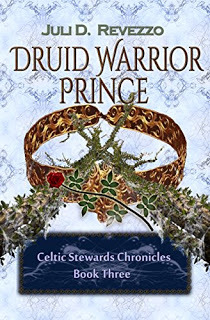 Gwenevieve Mackenís well-ordered world falls into chaos as encroaching interlopers scheme to possess both her and her land. Although sheís been trained to spot the signs of inhuman evil in men, the amassing armies take on guises she never expected.When a foreign guardian presents himself as her only option for salvation, Gwenevieve must make a choice between her desires, and fulfilling the mythic fate to which she was born. A forced marriage to a Tuatha dÈ Danann warrior isn't part of her plan.Amazon
Gwenevieve Mackenís well-ordered world falls into chaos as encroaching interlopers scheme to possess both her and her land. Although sheís been trained to spot the signs of inhuman evil in men, the amassing armies take on guises she never expected.When a foreign guardian presents himself as her only option for salvation, Gwenevieve must make a choice between her desires, and fulfilling the mythic fate to which she was born. A forced marriage to a Tuatha dÈ Danann warrior isn't part of her plan.Amazon
Published on February 07, 2018 23:00
February 6, 2018
Author’s Inspiration ~ Merryn Allingham #History #HistoricalFiction @MerrynWrites
It is with the greatest of pleasure that I welcome historical fiction author, Merryn Allingham, on to the blog today. Merryn is going to share with us her inspirations behind her fabulous books.
Author’s Inspiration
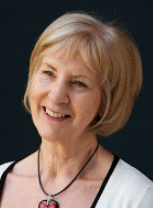 When authors are asked what inspired them to write a particular book, it’s very often a character who has been lurking in the back of their minds and needs his or her story told. Or a real life event the writer has read about in a newspaper or seen on television that has the creative mind humming. Or simply a snatch of conversation overheard on a bus or train or in a café. When I look back at the books I have written, it’s clear that no matter what historical period I’ve chosen, it’s place, a particular setting, that has galvanised me to write that very first word. In the Daisy’s War trilogy it was India and my family connections to the country, in a recent timeslip it was Hastings in East Sussex and the town’s association with the Pre-Raphaelites, and the book I have just sent to my agent is set in Constantinople in the first years of the 20th century when the Ottoman Empire still ruled swathes of the Middle East.
When authors are asked what inspired them to write a particular book, it’s very often a character who has been lurking in the back of their minds and needs his or her story told. Or a real life event the writer has read about in a newspaper or seen on television that has the creative mind humming. Or simply a snatch of conversation overheard on a bus or train or in a café. When I look back at the books I have written, it’s clear that no matter what historical period I’ve chosen, it’s place, a particular setting, that has galvanised me to write that very first word. In the Daisy’s War trilogy it was India and my family connections to the country, in a recent timeslip it was Hastings in East Sussex and the town’s association with the Pre-Raphaelites, and the book I have just sent to my agent is set in Constantinople in the first years of the 20th century when the Ottoman Empire still ruled swathes of the Middle East.The Buttonmaker’s Daughter and its follow -on, The Secret of Summerhayes, (though both are standalone novels) owe their existence to a memorable visit I made three years ago to the Lost Gardens of Heligan in Cornwall. ‘Lost’ because they were only rediscovered in 1990 and since that time have been lovingly restored – the work, in fact, is still ongoing. The gardens’ heyday was in the late Victorian/Edwardian period when their owners spent a great deal of money, time and effort, in creating a beautiful and exotic paradise. But, when in 1914, war came to England, everything changed. Over half the staff perished in the mud of Flanders and the gardens were left to a slow disintegration.
Heligan Gardeners 1900
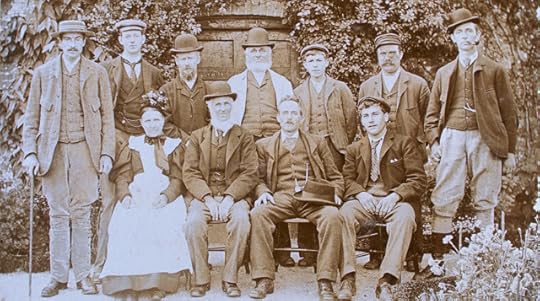
It was as though they slept for the next eighty years. And because they remained untouched, the buildings the gardeners had known in 1914 – the bothy, the bee boles, the pineapple pit, and wishing well among others – stayed essentially the same. These were what the pioneers who hacked their way through the undergrowth in 1990 discovered, along with what had once been a two acre vegetable garden, south facing walls for the fruit harvest and a series of beautifully designed individual spaces, among them the Flower Garden, the Sundial Garden, the Italian Garden and the Ravine.
The Flower Garden

There was plenty of evidence, too, from the previous century. Lead and zinc Victorian plant tags lay buried in the soil. A giant vine weaved its way through broken panes of glass in the walled garden. True romance! Not quite so romantic were the effects of requisitioning. In 1916 Heligan became a military hospital and during the Second World War housed the American army. The beautiful lawns, or what was left of them then, were concreted to provide hard standing for tanks and jeeps and the trees, many of them rare, used as target practice.
The Bothy
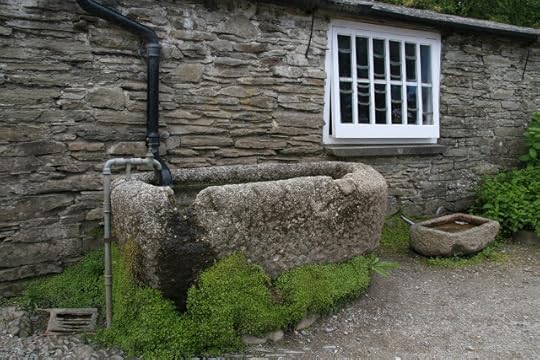
We had a brilliant guide the day we visited Heligan and it was one particular story he told that lodged in my mind. It concerned the ordinary men whose labour created the beauty of these gardens. On one particular day in the summer of 1914, every gardener on the estate downed tools and walked together to Redruth, to enlist at the local recruiting centre. Most of those men never returned. The Day Book, which would normally list every job completed, that day carried only the date and was never used again. With the loss of so many, the gardens slowly succumbed to the ravages of nature, until the ‘sleeping beauty’ was rediscovered some thirty years ago. The image of those men, honourable and courageous, leaving a hard but secure life, and walking together to enlist in what they saw as a just cause, stayed with me, and I knew I had to record that moment in a novel.
South facing wall used to grow fruit
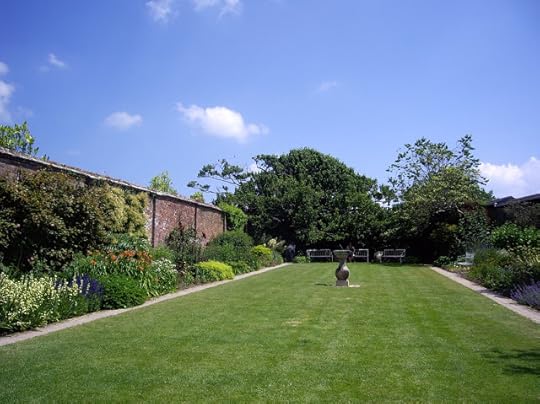
My fictional estate, Summerhayes, is nestled in the Sussex countryside, rather than Cornwall but it offers the same perfect idyll. And like Heligan, that idyll is disrupted by a war that looms ever closer. Disrupted, too, by conflict nearer to home - between neighbours and within the family itself. In The Buttonmaker’s Daughterthe summer of 1914 changes everything for the Summer family, as indeed it did for so many, and in The Secret of Summerhayes set in 1944, the estate has become a shadow of its former glory. Since the start of World War Two, the house and gardens have been requisitioned and the Canadian army are billeted there. Occupation by the army has had predictable results: the gardens are wild and impenetrable, the once beautiful lawns are under concrete and the Arts and Crafts house is battered and bedraggled. As with the earlier novel, historic events are central to The Secret of Summerhayes - in 1944 it is the dangers of the D Day invasion of Europe. And like The Buttonmaker’s Daughter, the novel traces a romance that grows strong in the face of dangers that emanate from much closer to home.
A small part of the Ravine

By the end of both books, Summerhayes has survived - and with the promise of future restoration. Who knows, one day I might visit again!
The Buttonmaker’s Daughter
 May, 1914.
May, 1914.Nestled in Sussex, the Summerhayes mansion seems the perfect country idyll.But with a long-running feud in the Summers family and tensions inEurope deepening, Summerhayes’ peaceful days are numbered.
For Elizabeth Summer, the lazy quiet of her home has become stifling.A chance meeting with Aiden Kellaway, an architect’s assistant,offers the secret promise of escape, but her marriage to a man of tradehas no place in her father’s plans. In the ensuing conflict, Elizabeth alongwith her family faces a dangerous future.
As the sweltering heat of 1914 builds to a storm, she faces a choicebetween family loyalty and an uncertain life with the man she loves.
One thing is definite: this summer will change everything.
Amazon US Amazon UK
The Secret of Summerhayes

A war-torn summerA house fallen into ruinA family decimated…Summer 1944: Bombed out of London by the Blitz, Bethany Merston takes up a post as companion to elderly Alice Summer, last remaining inhabitant of the dilapidated and crumbling Summerhayes estate. Now a shadow of its former glory, the house and gardens have been requisitioned by the military and show the scars of army occupation.Alice has struggled with the realities of war but is now plagued by anonymous letters and haunting visions of her old household. At first, Beth tries to convince her it’s all in her mind, but soon it becomes clear that a sinister force is once more at work in the Summer family.
The Secret of Summerhayes tells of dark secrets, almost-forgotten scandals and a household teetering on the edge of ruin.
Amazon US Amazon UK
Merryn Allingham
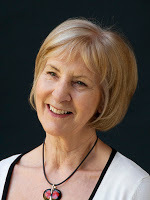 Merryn Allingham was born into an army family and spent her childhood on the move. Unsurprisingly, it gave her itchy feet and in her twenties she escaped from an unloved secretarial career to work as cabin crew and see the world. The arrival of marriage, children and cats meant a more settled life in the south of England where she has lived ever since. It also gave her the opportunity to go back to ‘school’ and eventually teach literature at university.Merryn has always loved books that bring the past to life, so when she began writing herself the novels had to be historical. Her latest books explore two pivotal moments in the history of Britain. The Buttonmaker’s Daughter is set in Sussex in the summer of 1914 as the First World War looms ever nearer and its sequel, The Secret of Summerhayes, forty years later in the summer of 1944 when D Day led to eventual victory in the Second World War. Along with the history, of course, there’s always plenty of mystery and romance to keep readers intrigued.
Merryn Allingham was born into an army family and spent her childhood on the move. Unsurprisingly, it gave her itchy feet and in her twenties she escaped from an unloved secretarial career to work as cabin crew and see the world. The arrival of marriage, children and cats meant a more settled life in the south of England where she has lived ever since. It also gave her the opportunity to go back to ‘school’ and eventually teach literature at university.Merryn has always loved books that bring the past to life, so when she began writing herself the novels had to be historical. Her latest books explore two pivotal moments in the history of Britain. The Buttonmaker’s Daughter is set in Sussex in the summer of 1914 as the First World War looms ever nearer and its sequel, The Secret of Summerhayes, forty years later in the summer of 1944 when D Day led to eventual victory in the Second World War. Along with the history, of course, there’s always plenty of mystery and romance to keep readers intrigued.Merryn loves to hear from readers, you can find her: Website Facebook Twitter
Published on February 06, 2018 23:00
February 5, 2018
Life in the time of Margaret Beaufort by Judith Arnopp #History #Tudors #WarOfTheRoses @JudithArnopp
Life in the time of Margaret Beaufort by Judith Arnopp
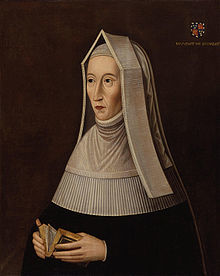 Lady Margaret Beaufort at prayer
Lady Margaret Beaufort at prayerFifteenth century England was dominated by the wars of the roses but for the vast majority daily life continued as usual. While the peasantry fought the twin perils of pestilence and penury, the nobility’s battle was for the English crown. For the upper classes the constant fluctuation between York and Lancaster made life unstable and monarchy and allegiance became fluid. The fall of one’s preferred king could mean loss of status, financial ruin and even death. One had to tread very cautiously; a careless word, a smile in the wrong quarter could spell the end of prosperity, the acquisition of property, the stripping of a title. The wisest kept their heads down and hoped the ‘right’ monarch would come out on top but for most, this was not an option. Margaret Beaufort, the protagonist of my trilogy The Beaufort Chronicles , was given no choices. She learned from a young age to think before speaking, to consider her actions before carrying them out and to place her trust carefully.
Even for the era she was born into, Margaret’s upbringing was remarkable. During her infancy, her father, John Beaufort, Earl and later Duke, of Somerset, took his own life while awaiting the pleasure of the increasingly unstable/inefficient King Henry VI. Margaret became the ward of one of the most powerful men of his day, William de la Pole, Earl of Suffolk (later Marquis and Duke) but she was allowed to remain in the home of her mother, Margaret Beauchamp, at least for the first decade of her life. She was just eight years old when Suffolk, taking advantage of Margaret’s wealth and status, married her to his young son, John, but since neither had yet reached their teens, the marriage remained unconsummated. Suffolk’s subsequent disgrace with the king and his ignoble death saw the marriage hastily annulled and Margaret’s future placed in the hands of the king, Henry VI.
Margaret’s early years were spent learning the graces required of an heiress of high status. We know she was well educated, more than one historian noting that her French was ‘first rate’ but it is unlikely she would have mastered many of the required skills by the time of her second marriage at approximately eleven years of age. It is my feeling that her education continued long after she left the schoolroom at Bletsoe. Margaret set great store on knowledge and in later life endowed many places of learning. After she was married to the half-brother of the king, Edmund Tudor, Earl of Richmond she accompanied him to a wild and unstable Wales. She would have needed to learn hard and fast, with lessons in politics and survival taking precedence over languages.
 Tomb Effigy of Edmund Tudor
Tomb Effigy of Edmund TudorEven in the early days of the conflict, war had a direct effect on Margaret. The homes she shared with Edmund at Caldicot and Lamphey would have rung with the boots of soldiers, the coming and going of messengers, and her husband was constantly away fighting. She was widowed just a year after the wedding when Edmund Tudor died at Carmarthen in 1456 in the act of defending Henry’s holdings in Wales. He left Margaret six months pregnant and vulnerable. She quickly turned for protection to her brother in law, Jasper Tudor, who housed her for the duration of her pregnancy at Pembroke Castle where she gave birth to a son, Henry Tudor. Shortly after his birth, keen to avoid another arranged marriage, she took matters into her own hands and with Jasper’s aid, betrothed herself to Henry Stafford, the younger son of the Duke of Buckingham.
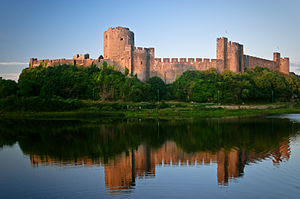 Pembroke Castle
Pembroke CastleDespite Stafford’s change of allegiance from Lancaster to York after the accession of Edward IV, the marriage appears to have been successful. It is doubtful Margaret was comfortable with this shift in loyalty, her blood and heart lay with Lancaster but perhaps it reveals an early example of Margaret’s fortitude.
She and Henry Stafford lived largely at Woking, making improvements to their properties and striving for acceptance at Edward’s court. At first Margaret was not invited to court but eventually, as Stafford proved his loyalty to Edward, she was welcomed at court. Calm seems to have settled on Margaret around this time, the only fly in her ointment being the exile of her son, Henry, who had fled overseas with his uncle Jasper when Edward took the throne. Margaret never ceased to petition for his return but was continually denied. In the unrest that surrounded the defection of the Earl of Warwick to Lancaster, the Staffords continued, at least outwardly, to support York. It was while fighting for Edward IV at Barnet in 1471 that Henry Stafford sustained wounds, dying a short time afterwards.
By 1472 Margaret had married again, this time to the powerful northern magnate, Thomas Stanley. Largely due to her husband’s relationship with King Edward, Margaret remained on good terms with the king and queen. She was on the verge of securing the return of her son’s rights and properties when Edward IV died unexpectedly at Easter in 1483.
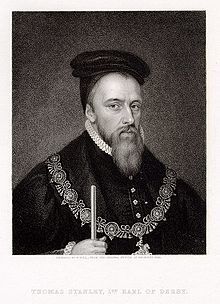 Portrait purported to be of the first Earl of Derby but the costume is of a later period.
Portrait purported to be of the first Earl of Derby but the costume is of a later period.During the period of unrest that followed, the juvenile King Edward VI’s throne was denied him and the crown instead placed on the head of his uncle, Richard of Gloucester. Margaret’s frustration and insecurity must have been immense but she did not falter. Stanley swore allegiance to King Richard while Margaret displayed loyalty, enjoying the honour of bearing Anne Neville’s train at the coronation. To all intents and purposes, Margaret had reconciled herself to Gloucester’s rule, it is only in hindsight we realise she was perhaps not as content as she seemed.
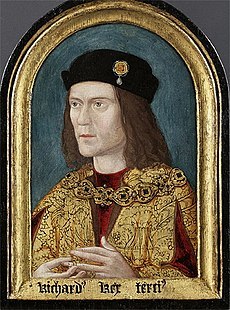 The earliest surviving portrait of Richard (c. 1520, after a lost original).
The earliest surviving portrait of Richard (c. 1520, after a lost original).Despite her apparent acceptance, the denouncement of Edward’s heirs and Gloucester’s accession to the throne rekindled Margaret’s political ambition, and shortly after the first reports of the disappearance of the princes in the tower, she began to plot with the dowager queen against King Richard.
Treason is an ugly word and to move against an anointed monarch is a perilous path to take. Margaret was all too aware of the consequences of her actions if they were discovered but something, be it blind ambition or moral outrage, drove her on. She played a major part in Buckingham’s rebellion and when her role in it was discovered Richard III’s leniency probably surprised Margaret as much as anyone. A man caught red handed at the same crime would have faced a traitor’s death but the king showed unprecedented clemency, and placed Margaret under house arrest in the charge of her husband, Thomas Stanley. This leniency provided the opportunity for Margaret to continue her intrigue from within her plush prison. She worked determinedly against Richard’s regime, not just to bring her son home but to crown him King of England.
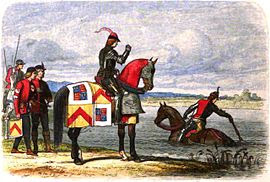 Buckingham finds the River Severn swollen after heavy rain, blocking his way to join the other conspirators.
Buckingham finds the River Severn swollen after heavy rain, blocking his way to join the other conspirators.Life in the time of Margaret Beaufort was both unstable and dangerous. Her role in the events during the years 1483 -5 would be less remarkable had she been ignorant of the possible consequences but Margaret Beaufort was raised amid bloodshed. She knew the price of treason. Before she was born her father died as a direct result of failing his king, and during the course of the wars that followed she lost uncles, cousins and friends, as well as suffering separation from her only son during his fourteen years of exile.
Margaret was indefatigable in her efforts, she negotiated her unstable world as assuredly as if she were playing a game of chess. Utilising her considerable acumen, she rose from a relatively insignificant position in the House of Lancaster to becoming, not just the most powerful woman in England, but the ultimate victor of the wars of the roses.
 Margaret's son — Henry VII
Margaret's son — Henry VIIJudith Arnopp
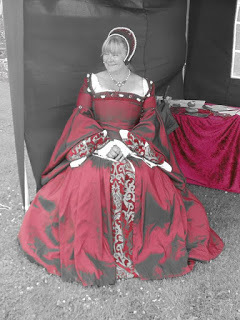 Judith Arnopp’s life-long passion for history eventually led her to the University of Wales where she gained a BA in English and Creative Writing, and a Masters in Medieval History.
Judith Arnopp’s life-long passion for history eventually led her to the University of Wales where she gained a BA in English and Creative Writing, and a Masters in Medieval History. Her first novel, Peaceweaver was published in 2009, quickly followed by The Forest Dwellers and The Song of Heledd but she remained largely unknown as an author until her first best-selling Tudor novel, The Winchester Goose. Since then she has continued to write in the Tudor era, producing five further novels covering the lives of Anne Boleyn, Katheryn Parr and Elizabeth of York.
The Beaufort Chronicles comprises of three volumes: The Beaufort Bride, The Beaufort Woman andThe King’s Mother tracing the fascinating life of Margaret Beaufort. She is currently engaged in researching the Dissolution of the monasteries for her eleventh novel which is yet to be named.
Judith’s non-fiction work has also been published in various historical anthologies, the latest being Sexuality and Its Impact on History which will be published in March 2018 by Pen and Sword Books. You will also find her work on many on-line magazines and blogs. Judith is easily accessible on her webpage and blog or you can follow her on social media. Website Website Blog Facebook Twitter
The Beaufort Chronicles

As King Henry VI slips into insanity and the realm of England teeters on the brink of civil war, a child is married to the mad king’s brother. Edmund Tudor, Earl of Richmond, takes his child bride into Wales where she discovers a land of strife and strangers.
At Caldicot Castle and Lamphey Palace Margaret must put aside childhood, acquire the dignity of a Countess and, despite her tender years, produce Richmond with a son and heir.
While Edmund battles to restore the king’s peace, Margaret quietly supports his quest; but it is a quest fraught with danger.
As the friction between York and Lancaster intensifies 14-year-old Margaret, now widowed, turns for protection to her brother-in-law, Jasper Tudor. At his stronghold in Pembroke, two months after her husband’s death, Margaret gives birth to a son whom she names Henry, after her cousin the king.
Margaret is small of stature but her tiny frame conceals a fierce and loyal heart and a determination that will not falter until her son’s destiny as the king of England is secured.
The Beaufort Bride traces Margaret’s early years from her nursery days at Bletsoe Castle to the birth of her only son in 1457 at Pembroke Castle. Her story continues in Book Two: The Beaufort Woman.
Amazon US Amazon UK
<!-- /* Font Definitions */ @font-face {font-family:Times; panose-1:2 0 5 0 0 0 0 0 0 0; mso-font-charset:0; mso-generic-font-family:auto; mso-font-pitch:variable; mso-font-signature:3 0 0 0 1 0;} @font-face {font-family:"MS 明朝"; mso-font-alt:"MS 明朝"; mso-font-charset:78; mso-generic-font-family:auto; mso-font-pitch:variable; mso-font-signature:-536870145 1791491579 18 0 131231 0;} @font-face {font-family:"Cambria Math"; panose-1:2 4 5 3 5 4 6 3 2 4; mso-font-charset:0; mso-generic-font-family:auto; mso-font-pitch:variable; mso-font-signature:-536870145 1107305727 0 0 415 0;} @font-face {font-family:Cambria; panose-1:2 4 5 3 5 4 6 3 2 4; mso-font-charset:0; mso-generic-font-family:auto; mso-font-pitch:variable; mso-font-signature:-536870145 1073743103 0 0 415 0;} /* Style Definitions */ p.MsoNormal, li.MsoNormal, div.MsoNormal {mso-style-unhide:no; mso-style-qformat:yes; mso-style-parent:""; margin:0cm; margin-bottom:.0001pt; mso-pagination:widow-orphan; font-size:12.0pt; font-family:Cambria; mso-ascii-font-family:Cambria; mso-ascii-theme-font:minor-latin; mso-fareast-font-family:"MS 明朝"; mso-fareast-theme-font:minor-fareast; mso-hansi-font-family:Cambria; mso-hansi-theme-font:minor-latin; mso-bidi-font-family:"Times New Roman"; mso-bidi-theme-font:minor-bidi;} a:link, span.MsoHyperlink {mso-style-priority:99; color:blue; mso-themecolor:hyperlink; text-decoration:underline; text-underline:single;} a:visited, span.MsoHyperlinkFollowed {mso-style-noshow:yes; mso-style-priority:99; color:purple; mso-themecolor:followedhyperlink; text-decoration:underline; text-underline:single;} .MsoChpDefault {mso-style-type:export-only; mso-default-props:yes; font-family:Cambria; mso-ascii-font-family:Cambria; mso-ascii-theme-font:minor-latin; mso-fareast-font-family:"MS 明朝"; mso-fareast-theme-font:minor-fareast; mso-hansi-font-family:Cambria; mso-hansi-theme-font:minor-latin; mso-bidi-font-family:"Times New Roman"; mso-bidi-theme-font:minor-bidi;} @page WordSection1 {size:595.0pt 842.0pt; margin:72.0pt 90.0pt 72.0pt 90.0pt; mso-header-margin:35.4pt; mso-footer-margin:35.4pt; mso-paper-source:0;} div.WordSection1 {page:WordSection1;} </style></div><br />
Published on February 05, 2018 23:00
The Coffee Pot Book Club
The Coffee Pot Book Club (formally Myths, Legends, Books, and Coffee Pots) was founded in 2015. Our goal was to create a platform that would help Historical Fiction, Historical Romance and Historical
The Coffee Pot Book Club (formally Myths, Legends, Books, and Coffee Pots) was founded in 2015. Our goal was to create a platform that would help Historical Fiction, Historical Romance and Historical Fantasy authors promote their books and find that sometimes elusive audience. The Coffee Pot Book Club soon became the place for readers to meet new authors (both traditionally published and independently) and discover their fabulous books.
...more
...more
- Mary Anne Yarde's profile
- 159 followers



